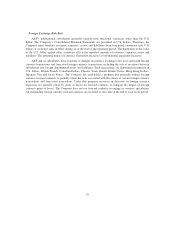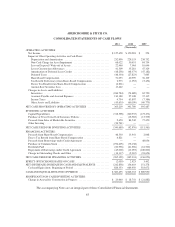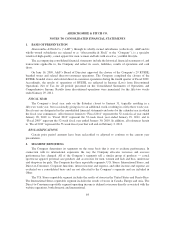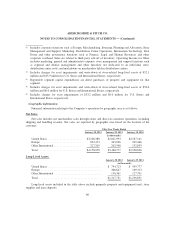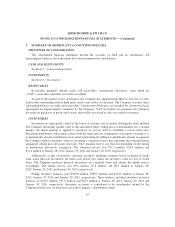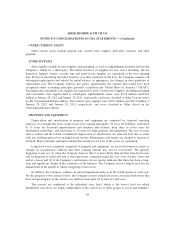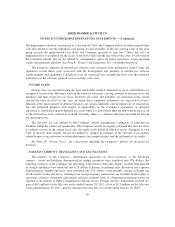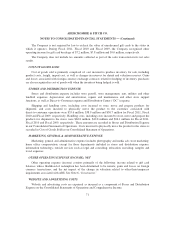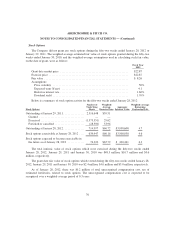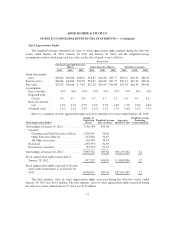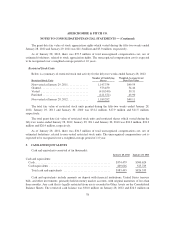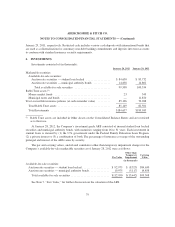Abercrombie & Fitch 2011 Annual Report Download - page 72
Download and view the complete annual report
Please find page 72 of the 2011 Abercrombie & Fitch annual report below. You can navigate through the pages in the report by either clicking on the pages listed below, or by using the keyword search tool below to find specific information within the annual report.ABERCROMBIE & FITCH CO.
NOTES TO CONSOLIDATED FINANCIAL STATEMENTS — (Continued)
The impairment evaluation is performed as a two-step test. First, the Company utilizes an undiscounted future
cash flow model to test the individual asset groups for recoverability. If the net carrying value of the asset
group exceeds the undiscounted cash flows, the Company proceeds to step two. Under step two, an
impairment loss is recognized for the excess of net book value over the fair value of the assets. Factors used in
the evaluation include, but are not limited to, management’s plans for future operations, recent operating
results and projected cash flows. See Note 8, “Property and Equipment, Net,” for further discussion.
The Company expenses all internal-use software costs incurred in the preliminary project stage and
capitalizes certain direct costs associated with the development and purchase of internal-use software
within property and equipment. Capitalized costs are amortized on a straight-line basis over the estimated
useful lives of the software, generally not exceeding seven years.
INCOME TAXES
Income taxes are calculated using the asset and liability method. Deferred tax assets and liabilities are
recognized based on the difference between the financial statement carrying amounts of existing assets and
liabilities and their respective tax bases. Deferred tax assets and liabilities are measured using current
enacted tax rates in effect for the years in which those temporary differences are expected to reverse.
Inherent in the measurement of deferred balances are certain judgments and interpretations of enacted tax
law and published guidance with respect to applicability to the Company’s operations. A valuation
allowance is established against deferred tax assets when it is more likely than not that some portion or all
of the deferred tax assets will not be realized. Currently, there is a valuation allowance provided for foreign
net operating losses.
The effective tax rate utilized by the Company reflects management’s judgment of expected tax
liabilities within the various tax jurisdictions. The Company records tax expense or benefit that does not relate
to ordinary income in the current fiscal year discretely in the period in which it occurs. Examples of such
types of discrete items include, but are not limited to; changes in estimates of the outcome of tax matters
related to prior years; provision-to-return adjustments; tax-exempt income; and the settlement of tax audits.
See Note 14, “Income Taxes,” for a discussion regarding the Company’s policies for uncertain tax
positions.
FOREIGN CURRENCY TRANSLATION AND TRANSACTIONS
The majority of the Company’s international operations use local currencies as the functional
currency. Assets and liabilities denominated in foreign currencies were translated into U.S. dollars (the
reporting currency) at the exchange rate prevailing at the balance sheet date. Equity accounts denominated
in foreign currencies were translated into U.S. dollars at historical exchange rates. Revenues and expenses
denominated in foreign currencies were translated into U.S. dollars at the monthly average exchange rate
for the period. Gains and losses resulting from foreign currency transactions are included in the results of
operations; whereas, translation adjustments and inter-company loans of a long-term investment nature are
reported as an element of Other Comprehensive Income (Loss). Foreign currency transactions resulted in a
gain of $0.5 million for the fifty-two weeks ended January 28, 2012, a loss of $3.3 million for the fifty-two
weeks ended January 29, 2011, and was immaterial for the fifty-two weeks ended January 30, 2010.
69


